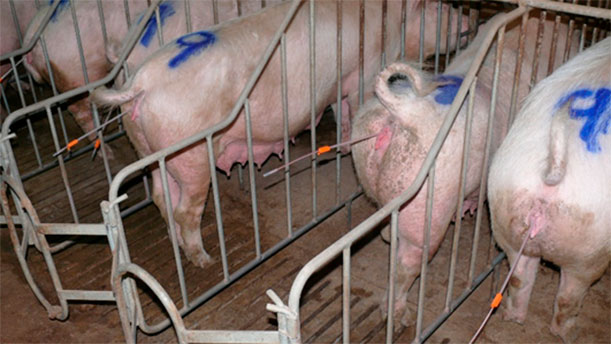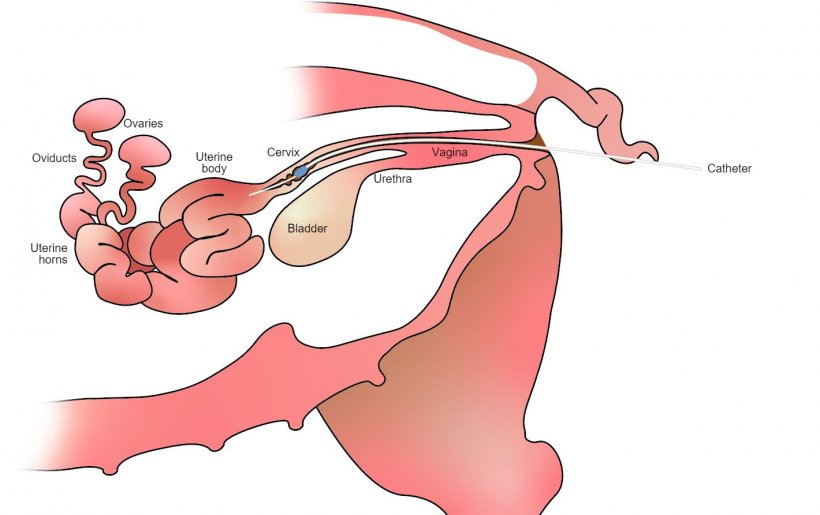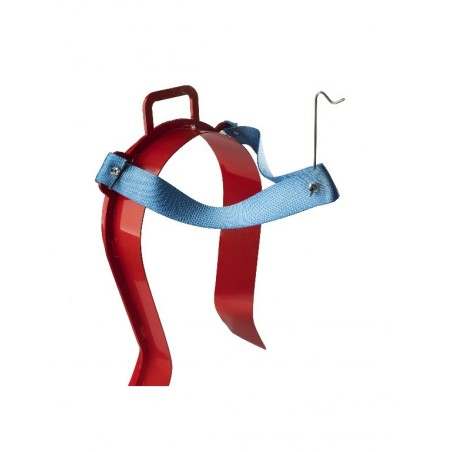The correct procedure for post-cervical artificial insemination (PCAI) involves good heat detection. Once we have peformed the heat detection, we put the boar(s) away and wait a few minutes (often the time it takes to go get the semen doses is enough for the sow's level of stimulation to go down) and then we inseminate without the boar present.
To inseminate, we first clean the vulva. This cleaning is even more important here than with traditional insemination because the inner cannula will be introduced up to the beginning of the uterus, bypassing the first physical defense to contamination- the cervix.

We place catheters in four or five sows; this way we give the cervix time to relax, and we introduce the inner cannula (Photo 1). If the cannula does not enter a sow easily, we leave and move on to the next one to give her a little more time and then try again. Not all sows need the same amount of time to relax, but what is true is that the only sow that can make us wait ("waste time") is the last one.

Photo 1: Working in an orderly fashion is important with PCAI. If more than 5 sows are prepared (getting them to stand, cleaning the vulva, placing the external catheter) per worker at one time, we run the risk of the sows laying back down again, the catheter tip being dislodged or becoming dirty, etc.
Why is applying pressure to the semen dose important during postcervical insemination?
In a well-done PCAI, we deposit the semen in the uterine body (Figure 1), so we need less dose volume than with traditional insemination. In addition, we must consider that the uterus "hangs" inside the abdomen when the sow is standing. Therefore, the semen falls into the uterine body in a cascade. Thus, in a well done PCAI there cannot be any back flow whatsoever.

Figure 1. With post-cervical insemination the semen is deposited in the uterine body, past the cervix.
Therefore, in this particular insemination technique the fact of applying pressure on the semen dose acts as a quality control indicator for the process. If at squeezing the semen dose we observe semen backflow it means that we have placed the catheter and/or cannula incorrectly, and we will be depositing the semen in the cervix, instead of in the uterus. This is a sign that the insemination is incorrect. In this case we must "restart" the process, pulling back the cannula about 20 cm, repositioning the catheter, reintroducing the cannula, and inseminating again.
This is one of the major advantages of the post-cervical technique: at the end of the insemination you know if you have done it well or not. With traditional insemination on the other hand, back flow is much more variable and unpredictable, and therefore it is difficult to assess if insemination has been performed correctly.
You have often explained the importance of massaging the cervix in a circular motion at the end of the insemination. Why do you think this is so important?
In natural mating, when the boar finishes ejaculating and before the mating is finished, he performs some semicircular movements with his penis. The purpose of this movement is to "let the sow know" that ejaculation has ended and that she must move the semen towards the uterus.
The massage of the cervix aims to simulate this "signal". That is why it is important to partially remove the cannula when the insemination is finished, and to move the catheter itself (while still in the cervix) as if we were beating an egg for a few seconds. Often this is done incorrectly, moving the catheter while it is being removed, when the massage at the cervix should be a stimulation movement and not an extraction movement.
In addition, the massage has a second function just as important as the previous one. By massaging the cervix in a circular motion with the catheter, we stimulate the cervix again, so it will contract and we will see back flow if we have deposited the semen in the cervix and not in the uterus. Again, this is a measure that acts as quality control.
The use of the boar in PCAI
This is a controversial issue, for which there is no need to create a dogma.
PCAI was described as a technique used preferably without the boar present. The reason for this is that the process of tension-relaxation that the cervix undergoes is less predictable when the boar is in front of the sow. This effect is easily seen during traditional insemination, where the presence of the male is generally recommended, where there are sows that begin to "absorb" the semen in a few seconds and others need many minutes.
Thus, in PCAI without a boar in front, the relaxation of the cervix after inserting the catheter will occur earlier and at a more predictable time, and the total insemination time will be reduced.
So insemination can be done with the boar in front?
Yes, insemination will just go more slowly, and perhaps there will be an increased number of sows where the cannula enters with more difficulty, or even not at all, because the cervix will not be completely relaxed.
It is true that on very large farms, where many sows are asked to stand at the same time to inseminate, the use of the boar in front makes it easier for the sows to stand, and not lie down so easily. This is especially useful in hot weather, or on farms where sows come out of the farrowing rooms with some calcium deficiency and they stand for a short time.
Another situation in which putting the boar in front is recommended is in Iberian sows. They are so reluctant to contact and insemination, that it is much easier to do if they have the boar in front of them.
An intermediate situation which allows the sows to remain standing and facilitates the relaxation of the cervix, is to inseminate a few minutes after the boar has passed by, i.e. the male is put away and insemination is done immediately, or it is even possible to inseminate without putting the boar away, while he is several meters in front of the point of insemination.
Occasionally, one may not be able to get the cannula inserted into a certain sow. What percentage of sows that cannot be post-cervically inseminated do you consider acceptable on a farm?
All sows that have already farrowed should be able to be inseminated using PCAI. Gilts are not usually post-cervically inseminated because "they don't know what is happening." This is the first time they are experiencing these sensations and, in a way, they are scared. This provokes the contraction of the cervix as a "defense" which is excessively intense and continuous, even reaching a contraction as strong and sustained that it will prevent the passage of the cannula, a situation that is exacerbated each time the cervix is hit with each attempt to pass the cannula. This can also occur in first parity sows. In fact, on some farms, after a failed attempt to perform PCAI, the cannula is removed and traditional insemination is performed.
Currently, we are working on a minimally invasive post-cervical technique that prevents defensive contractions and allows gilts to be inseminated.
The post-cervical insemination technique is a very useful tool as an alternative to traditional insemination. It allows us to work faster and use a lesser volume of semen, but it is essential to know the differences between PCAI and traditional insemination, and therefore what management guidelines we should follow to perform it correctly.







